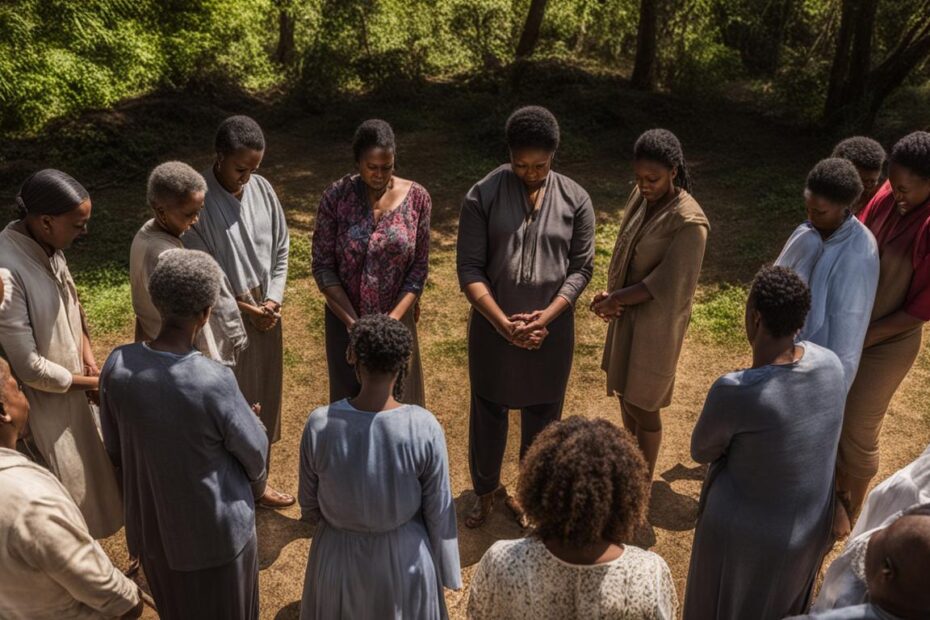Prayer ministry is an essential part of spiritual growth and engagement in churches. However, to truly make an impact through prayer, it is crucial to understand the principles and practices that lead to effectiveness. In this article, we will explore the secrets to conducting prayer ministry effectively and provide practical tips and insights for those involved or interested in starting a prayer ministry. Drawing from biblical teachings and recommendations from experienced coordinators, you will gain valuable guidance on how to make your prayer ministry a powerful force of spiritual transformation.
Key Takeaways:
- Understand the principles of effective prayer for a powerful impact.
- Organize and lead successful prayer meetings with key elements in mind.
- Cultivate a culture of prayer throughout the church community.
- Recognize the role of the prayer ministry coordinator in fostering a successful prayer ministry.
- Develop a well-defined prayer ministry plan to ensure sustainability and impact.
The Power of Effective Prayer
Effective prayer is a transformative and powerful practice that holds tremendous potential to impact individuals and communities. It is not merely a ritualistic act, but a sacred conversation with the divine that can bring about remarkable change. To truly understand the power of effective prayer, we must explore the principles and steps that contribute to its efficacy.
One crucial factor in effective prayer is aligning our desires and motives with God’s will. The Bible teaches us that prayers offered with wrong motives or selfish intentions may hinder their effectiveness. Therefore, it is essential to approach prayer with a humble and submissive heart, seeking God’s guidance and aligning our desires with His purpose. As James 5:16 reminds us, “The prayer of a righteous person is powerful and effective.”
“Prayer is not asking. It is a longing of the soul. It is daily admission of one’s weakness. It is better in prayer to have a heart without words than words without a heart.”
Mahatma Gandhi
Another key aspect of effective prayer is fervency and inspiration from the Holy Spirit. When we pray with passion and sincerity, allowing the Holy Spirit to guide our words, our prayers become infused with divine power. As Romans 8:26 assures us, “The Spirit helps us in our weakness. We do not know what we ought to pray for, but the Spirit himself intercedes for us through wordless groans.”
In addition to these principles, effective prayer requires righteousness and a commitment to living a godly life. As we strive to live in accordance with God’s commandments, our prayers are more likely to align with His will. 1 John 3:22 teaches us, “And we will receive from him whatever we ask because we obey him and do the things that please him.”
The Steps for Prayer Ministry
- Step 1: Establish a prayerful atmosphere: Create a space that invites people to engage in prayer by setting up a dedicated prayer room or incorporating prayer stations in existing spaces.
- Step 2: Recruit and train prayer warriors: Identify individuals passionate about prayer ministry and provide them with training and resources to grow in their spiritual journey.
- Step 3: Develop a prayer strategy: Formulate a plan to guide your prayer ministry, including regular prayer meetings, targeted intercession, and intentional outreach through prayer.
- Step 4: Encourage personal prayer: Foster a culture of individual prayer by providing prayer journals, prayer prompts, and encouraging regular personal devotion and reflection.
- Step 5: Organize corporate prayer events: Coordinate special prayer events, such as prayer vigils, prayer walks, or community prayer gatherings, to promote unity and fervency in prayer.
- Step 6: Cultivate a heart of intercession: Teach and model the importance of interceding for others, both within the church and in the wider community, to develop a compassionate and outward-focused prayer ministry.
- Step 7: Celebrate answered prayers: Regularly share testimonies of answered prayers within the church community to encourage faith and build a culture of expectation.
| Principles of Effective Prayer | Steps for Prayer Ministry |
|---|---|
| Align motives with God’s will | Establish a prayerful atmosphere |
| Fervency and inspiration from the Holy Spirit | Recruit and train prayer warriors |
| Live a godly life | Develop a prayer strategy |
| Encourage personal prayer | |
| Organize corporate prayer events | |
| Cultivate a heart of intercession | |
| Celebrate answered prayers |
Key Elements for a Successful Prayer Meeting
Leading a prayer ministry and organizing prayer meetings require careful consideration of key elements that contribute to a successful and impactful gathering. By incorporating these elements, prayer meetings can foster a deep sense of connection with God and bring about transformation in the lives of participants.
Short Devotion from Scripture
Begin the prayer meeting with a short devotion from Scripture, focusing on a passage or theme that sets the tone for the time of prayer. This allows participants to reflect on God’s Word, align their hearts with His truth, and prepare themselves spiritually. The devotion can be shared by the prayer ministry coordinator or a designated leader, offering insights and encouragement that lead into a spirit of worship and intercession.
Focused Times of Doxological Prayer
Doxological prayer, also known as praise and worship, is an essential element of a successful prayer meeting. Dedicate specific times during the gathering for participants to collectively offer praise and adoration to God. This can be done through singing hymns, choruses, or through spoken prayers of worship. The act of focusing on God’s greatness, goodness, and faithfulness helps to create an atmosphere of reverence and gratitude, preparing hearts for deeper communion with Him.
Specific Areas of Intercession
Designate specific areas of intercession where participants can pray for the needs and concerns of individuals, the church, the community, and the world. This can be done by providing a list of prayer requests or through verbal sharing. By focusing on specific areas, prayer meetings become targeted, allowing individuals to join their faith and prayers together for greater impact. It also helps to bring a sense of unity and purpose to the gathering.
Opportunities for Personal Prayer Requests
Ensure that prayer meetings include opportunities for individuals to share personal prayer requests. This can be done through a time of open prayer where participants have the freedom to voice their needs or through the use of prayer request cards that can be submitted anonymously. By offering space for personal prayer requests, participants feel heard, supported, and loved by the community. It also allows for specific and personal intercession for each individual’s unique needs.

By incorporating these key elements into prayer meetings, we can develop a prayer ministry that is vibrant, engaging, and impactful. These elements create an atmosphere that encourages deeper communion with God, fosters unity among the participants, and brings transformation through the power of prayer. Whether you are starting a prayer ministry or looking to enhance an existing one, remember to prioritize these essential elements for a successful prayer meeting.
Starting a Prayer Ministry: Cultivating a Culture of Prayer in the Church
Starting a prayer ministry is not just about organizing prayer meetings; it’s about cultivating a culture of prayer throughout the church community. By providing resources and opportunities for individual and corporate prayer, the church can create an environment that empowers its members to develop a vibrant and consistent prayer life.
One effective way to cultivate a culture of prayer is by offering prayer ministry resources. These resources can include prayer guides, books on prayer, and online platforms that provide prayer prompts and inspiration. By equipping individuals with these resources, the church encourages them to deepen their prayer life and explore different prayer practices.
Another way to foster a culture of prayer is by organizing prayer events and initiatives. This can include prayer retreats, where individuals can set aside dedicated time for prayer and reflection. Emphasis weeks focused on prayer can also be organized, with specific themes and prayer points for the congregation to engage with. These events create opportunities for the whole church community to come together in prayer, strengthening the sense of unity and shared purpose.
Prayer Ministry Resources
| Resource | Description |
|---|---|
| Prayer Guides | A collection of prayers and prompts to guide individuals in their personal prayer time. |
| Books on Prayer | Insightful books that provide teachings and reflections on prayer, offering guidance for deepening one’s prayer life. |
| Online Prayer Platforms | Web-based platforms that offer prayer prompts, devotionals, and connect individuals for virtual prayer groups. |
By creating a supportive environment and providing prayer ministry resources, the church fosters a culture of prayer that extends beyond organized prayer meetings. This allows individuals to grow in their prayer life and experience the transformative power of prayer.
The Role of the Prayer Ministry Coordinator
Within the prayer ministry, the role of the prayer ministry coordinator is crucial in providing leadership and organization. The coordinator serves as a guide and facilitator, ensuring that the prayer ministry operates smoothly and effectively. They play a vital role in fostering a culture of prayer within the church community.
A prayer ministry coordinator should possess certain qualities and skills to fulfill their responsibilities effectively. A strong personal prayer life is essential, as it serves as a foundation for leading others in prayer. Spiritual maturity is also important, as the coordinator should be able to provide guidance and discernment in prayer initiatives. Additionally, organizational abilities and effective communication skills are necessary to coordinate prayer meetings and maintain communication with the church leadership.
The responsibilities of the prayer ministry coordinator include identifying individuals interested in prayer ministry and recruiting and training them. They provide guidance and resources to those involved, ensuring they have the necessary support to carry out their roles. The coordinator also plays a key role in coordinating prayer initiatives, such as focused times of intercession or prayer chains, and maintaining communication with the church leadership to align the prayer ministry with the overall vision and mission of the church.
Key Responsibilities of the Prayer Ministry Coordinator:
- Identifying individuals interested in prayer ministry and recruiting them
- Providing training and resources to prayer ministry participants
- Coordinating prayer initiatives, such as focused times of intercession or prayer chains
- Maintaining communication with the church leadership to align the prayer ministry with the overall vision and mission of the church
By fulfilling these responsibilities, the prayer ministry coordinator plays a vital role in nurturing a culture of prayer within the church. Their leadership and guidance contribute to the spiritual growth and engagement of the church community, fostering a deeper connection with God and an impactful prayer ministry.
Developing a Prayer Ministry Plan
Developing a prayer ministry plan is essential for the success and sustainability of your prayer ministry. With a well-defined plan, you can effectively carry out your mission and impact your church community. A prayer ministry plan should include several key components, including a compelling mission statement, practical goals and objectives, specific action plans, job descriptions for key roles, and a simple budget if necessary.
Your mission statement should align with the overall vision of your church and clearly communicate the purpose and focus of your prayer ministry. It should inspire and motivate both your team members and the church community as a whole. Here is an example of a mission statement for a prayer ministry:
“Our prayer ministry exists to create a culture of prayer in our church community, equipping and encouraging individuals to develop a vibrant and consistent prayer life, and interceding for the needs of our church, community, and world.”
Once you have a clear mission statement, you can establish practical goals and objectives that support your mission. These goals should be specific, measurable, achievable, relevant, and time-bound (SMART goals). For example, one of your goals could be to increase participation in prayer meetings by 20% over the next six months. Setting clear goals and tracking your progress will help you stay focused and motivated.
Table: Example Prayer Ministry Plan
| Component | Description |
|---|---|
| Mission Statement | Create a culture of prayer, equipping and encouraging individuals to develop a vibrant and consistent prayer life, and interceding for the needs of the church, community, and world. |
| Goals | Increase participation in prayer meetings by 20% over the next six months. Establish a prayer partner program for church members. Organize quarterly prayer retreats for the church community. |
| Action Plans | Implement a promotion strategy to raise awareness about prayer meetings. Create training resources for prayer partners. Secure a venue and guest speakers for the prayer retreats. |
| Job Descriptions | Prayer Ministry Coordinator: Provide leadership and coordination for the prayer ministry. Prayer Meeting Facilitators: Lead prayer meetings and create a welcoming atmosphere. |
| Budget | Allocate funds for promotional materials, training resources, and retreat expenses. |
With your plan in place, you can implement action plans that outline the specific steps and strategies you will take to achieve your goals. These action plans should be detailed and include deadlines, responsibilities, and resources needed. Regularly review and assess your action plans to ensure you’re making progress and making any necessary adjustments.
Finally, it’s important to have job descriptions for key roles within your prayer ministry. Clearly defining the responsibilities and expectations for these roles will help ensure smooth operation and accountability. Examples of key roles include the prayer ministry coordinator, prayer meeting facilitators, prayer partners, and intercessors.
Remember, a prayer ministry plan should serve as a guide and evolve with the needs and circumstances of your church. Regularly assess and update your plan to ensure it remains relevant and effective in advancing your prayer ministry’s mission.

Conclusion
In conclusion, a well-structured and organized prayer ministry is essential for the spiritual growth and engagement of a church community. By embracing the principles of effective prayer, such as fervency, righteousness, and alignment with God’s will, the prayer ministry can become a powerful source of transformation and impact.
Successful prayer meetings play a crucial role in the prayer ministry, and incorporating key elements like devotions, doxological prayer, intercession, and personal prayer requests can create a rich and transformative experience for participants. It is important to avoid common pitfalls and foster genuine participation to ensure the success of these meetings.
However, a thriving prayer ministry goes beyond organized prayer meetings. Cultivating a culture of prayer throughout the church community is vital. By providing resources and opportunities for individual and corporate prayer, such as prayer partners, chains, retreats, and emphasis weeks, the church can empower its members to develop a vibrant and consistent prayer life.
Lastly, a dedicated prayer ministry coordinator is crucial in leading and organizing the prayer ministry. This individual should possess a strong personal prayer life, spiritual maturity, and the ability to organize and provide leadership. By fulfilling their responsibilities, the role of the coordinator becomes instrumental in fostering a culture of prayer within the church and ensuring the success of the prayer ministry.
FAQ
What factors can hinder the effectiveness of prayer?
Wrong motives, unconfessed sin, unforgiveness, and broken relationships can hinder the effectiveness of prayer.
What are the key elements for a successful prayer meeting?
A short devotion from Scripture, focused times of doxological prayer, specific areas of intercession, and opportunities for personal prayer requests are key elements for a successful prayer meeting.
How can a church cultivate a culture of prayer?
A church can cultivate a culture of prayer by providing resources and opportunities for individual and corporate prayer, such as prayer partners, prayer chains, prayer retreats, and emphasis weeks.
What is the role of the prayer ministry coordinator?
The prayer ministry coordinator leads and organizes the prayer ministry, identifies individuals interested in prayer ministry, provides training and resources, coordinates prayer initiatives, and maintains communication with the church leadership.
How important is it to have a prayer ministry plan?
Having a prayer ministry plan is crucial for the success and sustainability of the prayer ministry. It includes a compelling mission statement, goals and objectives, action plans, job descriptions for key roles, and a simple budget if necessary.
What should be the focus of a prayer ministry?
The focus of a prayer ministry should be to deepen the spiritual lives of church members and impact the community for the glory of God.
Source Links
- https://thedecablog.wordpress.com/2013/04/04/conducting-effective-prayer-meetings/
- https://adventsourcecms.blob.core.windows.net/media/77dc4de2-6552-4395-89eb-ab6501216189/QuickStartGuide_PrayerMinistriesCoordinator.pdf?v=637176440685669671
- https://www.wordsoflife.co.uk/bible-studies/study-11-the-secret-of-effective-prayer/









